Salby M.L. Fundamentals of Atmospheric Physics
Подождите немного. Документ загружается.

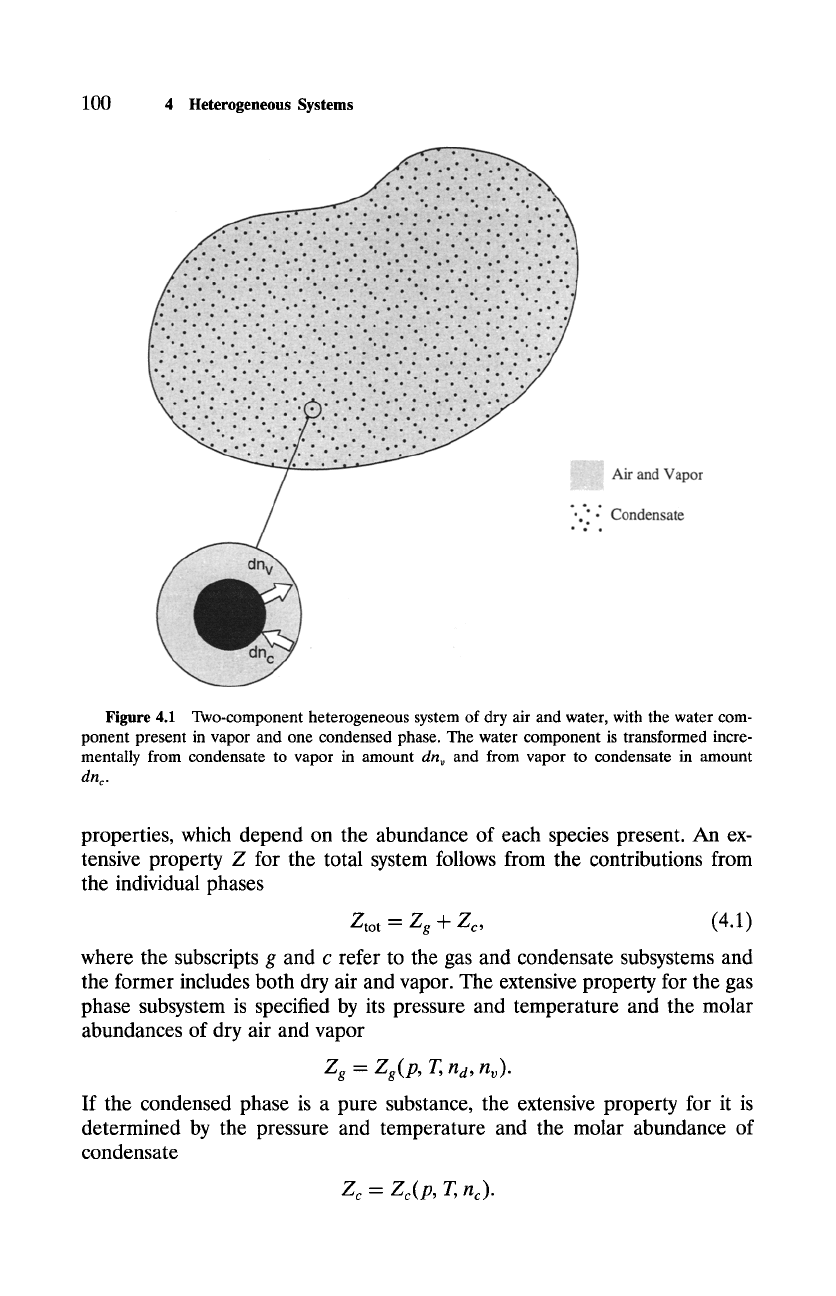
100
4
Heterogeneous Systems
i!i!i!i!i~!ii!iiiiiii!ili~i~iii!
Air and Vapor
".~ ~ Condensate
9 9 ~
Figure 4.1 Two-component heterogeneous system of dry air and water, with the water com-
ponent present in vapor and one condensed phase. The water component is transformed incre-
mentally from condensate to vapor in amount
dn,,
and from vapor to condensate in amount
dnc.
properties, which depend on the abundance of each species present. An ex-
tensive property Z for the total system follows from the contributions from
the individual phases
Zto t = Zg -+-
Zc,
(4.1)
where the subscripts g and c refer to the gas and condensate subsystems and
the former includes both dry air and vapor. The extensive property for the gas
phase subsystem is specified by its pressure and temperature and the molar
abundances of dry air and vapor
Zg = Zg(p, T, ncl , nv).
If the condensed phase is a pure substance, the extensive property for it is
determined by the pressure and temperature and the molar abundance of
condensate
= Z (p, nc).
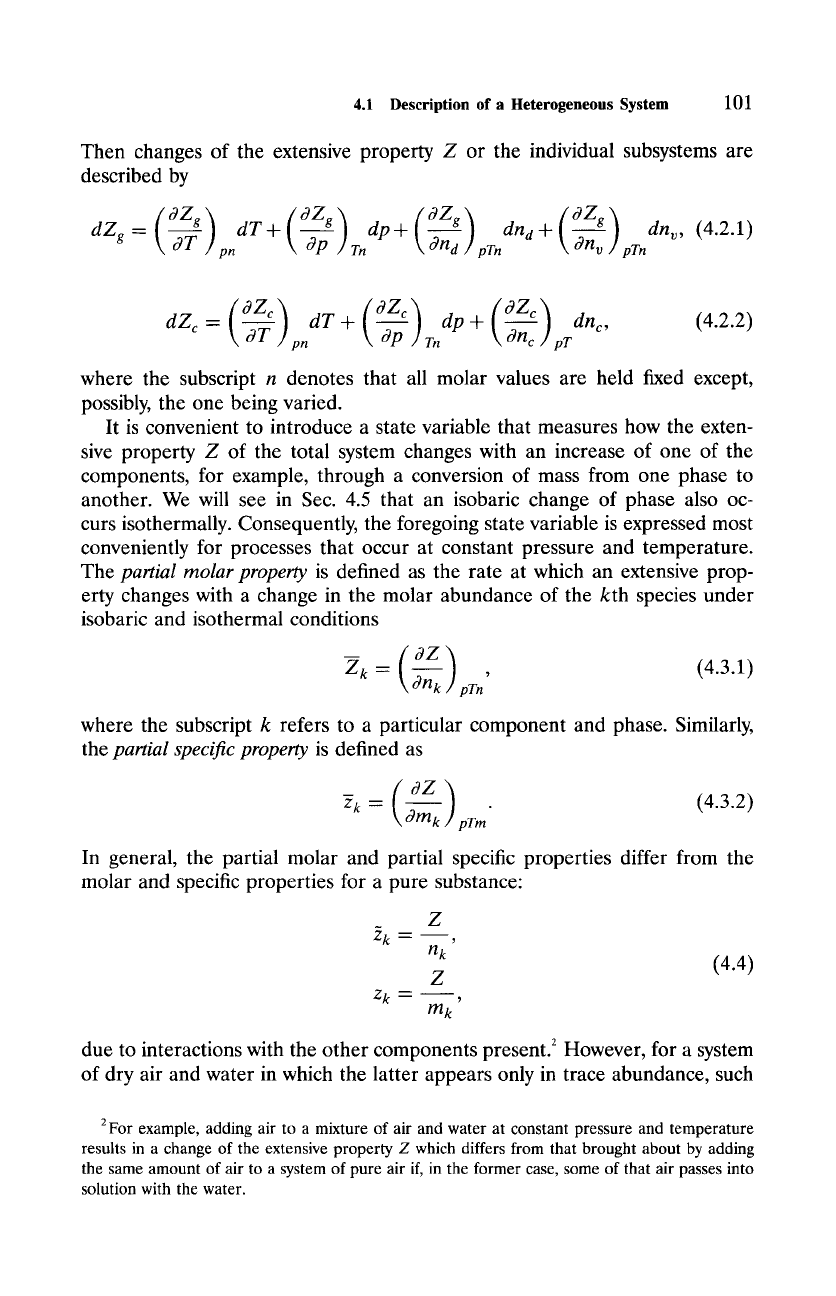
4.1 Description of a Heterogeneous System
101
Then changes of the extensive property Z or the individual subsystems are
described by
= alp+ and+ \-~n,/ dn,,
(4.2.11
dZg ~ dTnl- lk--~-P Tn ~ pTn pTn
pn
OZr dZc~
dZ c - \---ff~-) dT+ (--fffi-p ] dp+ ( OZc dn c,
(4.2.2)
)
- nc.
where the subscript n denotes that all molar values are held fixed except,
possibly, the one being varied.
It is convenient to introduce a state variable that measures how the exten-
sive property Z of the total system changes with an increase of one of the
components, for example, through a conversion of mass from one phase to
another. We will see in Sec. 4.5 that an isobaric change of phase also oc-
curs isothermally. Consequently, the foregoing state variable is expressed most
conveniently for processes that occur at constant pressure and temperature.
The
partial molar property
is defined as the rate at which an extensive prop-
erty changes with a change in the molar abundance of the kth species under
isobaric and isothermal conditions
2 k --(O0--~nZk) , (4.3.1)
pTn
where the subscript k refers to a particular component and phase. Similarly,
the
partial specific property
is defined as
2k = 9 (4.3.2)
pTm
In general, the partial molar and partial specific properties differ from the
molar and specific properties for a pure substance:
Z
Z k = ~,
nk (4.4)
Z
Z k = ~~
mk
due to interactions with the other components present. 2 However, for a system
of dry air and water in which the latter appears only in trace abundance, such
2 For example, adding air to a mixture of air and water at constant pressure and temperature
results in a change of the extensive property Z which differs from that brought about by adding
the same amount of air to a system of pure air if, in the former case, some of that air passes into
solution with the water.
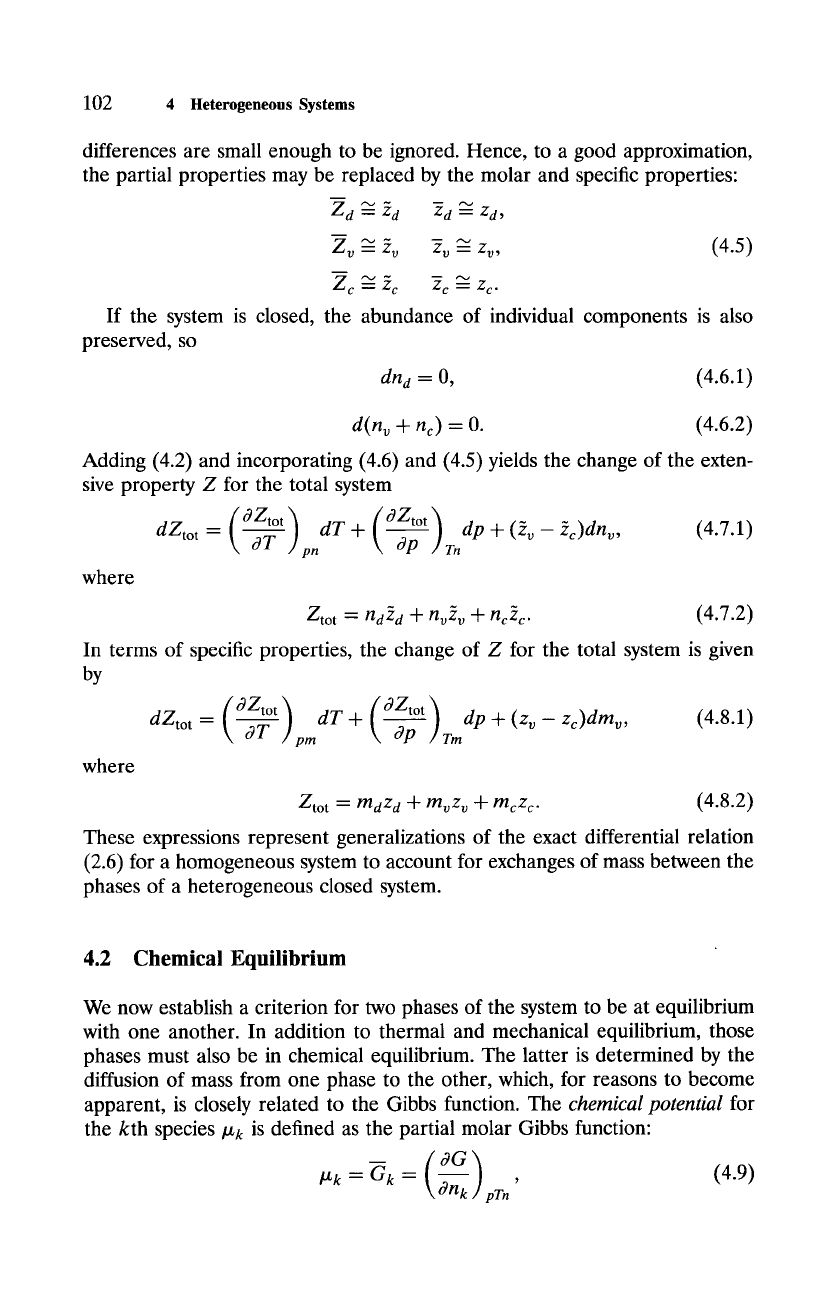
102
4
Heterogeneous Systems
differences are small enough to be ignored. Hence, to a good approximation,
the partial properties may be replaced by the molar and specific properties:
Zd ~" Zd Zd Zd,
Z v '~ 2 v z v - Zv,
(4.5)
Zc ~ 2c Zc ~ Zc"
If the system is closed, the abundance of individual components is also
preserved, so
dn e
= O, (4.6.1)
d(n v + nc)
= 0. (4.6.2)
Adding (4.2) and incorporating (4.6) and (4.5) yields the change of the exten-
sive property Z for the total system
() (~176
dZto t
--
aZt~
dT + dp +
(2 v -
2c)dnv,
(4.7.1)
OT
pn Ik ~P Tn
where
Zto t -
na2 a + no2 v + nc2 c.
(4.7.2)
In terms of specific properties, the change of Z for the total system is given
by
where
) ( ~176 )
--
( ~176
dr + dp + (z v - zc)dmv,
(4.8.1)
dZt~
Ik ~ Z pm ~ Tm
Ztot m
mdZd §
mvzv + mcZc"
(4.8.2)
These expressions represent generalizations of the exact differential relation
(2.6) for a homogeneous system to account for exchanges of mass between the
phases of a heterogeneous closed system.
4.2 Chemical Equilibrium
We now establish a criterion for two phases of the system to be at equilibrium
with one another. In addition to thermal and mechanical equilibrium, those
phases must also be in chemical equilibrium. The latter is determined by the
diffusion of mass from one phase to the other, which, for reasons to become
apparent, is closely related to the Gibbs function. The
chemical potential
for
the kth species/Zk is defined as the partial molar Gibbs function:
49,
pTn
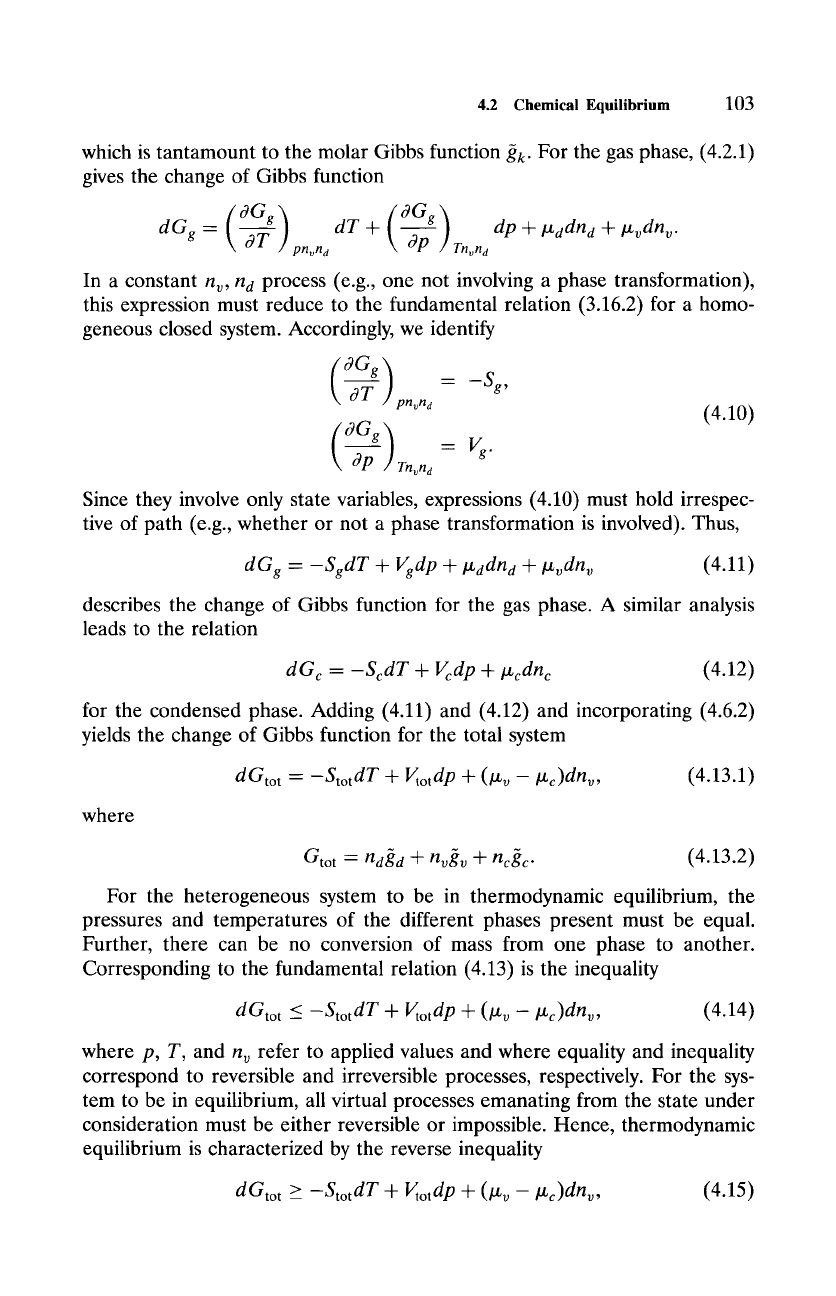
4.2 Chemical Equilibrium 103
which is tantamount to the molar Gibbs function gk" For the gas phase, (4.2.1)
gives the change of Gibbs function
=- dT + dp
+ tzddnd +
tzvdn ~.
dGg dT J pnvn u ~ Tnvn u
In a constant nv, nd process (e.g., one not involving a phase transformation),
this expression must reduce to the fundamental relation (3.16.2) for a homo-
geneous closed system. Accordingly, we identify
(
OGg~ = -Sg
3T } p,,,,,~ ' (4.10)
3Gg
-
Since they involve only state variables, expressions (4.10) must hold irrespec-
tive of path (e.g., whether or not a phase transformation is involved). Thus,
dGg = -SgdT + Vgdp + IXddnd + Ia, vdn v
(4.11)
describes the change of Gibbs function for the gas phase. A similar analysis
leads to the relation
dGc = -ScdT + Vcdp + Iu.cdnc
(4.12)
for the condensed phase. Adding (4.11) and (4.12) and incorporating (4.6.2)
yields the change of Gibbs function for the total system
dGto t =
-StotdT + Vtotdp --[- (tj, v
--
tzc)dnv,
(4.13.1)
where
Gto t --
nd~,d +
n~ao~ + ncaoc.
(4.13.2)
For the heterogeneous system to be in thermodynamic equilibrium, the
pressures and temperatures of the different phases present must be equal.
Further, there can be no conversion of mass from one phase to another.
Corresponding to the fundamental relation (4.13) is the inequality
dGto t _<
-StotdT +
Vtotd p
-k- (tZv - tzc)dn~,
(4.14)
where p, T, and n~ refer to applied values and where equality and inequality
correspond to reversible and irreversible processes, respectively. For the sys-
tem to be in equilibrium, all virtual processes emanating from the state under
consideration must be either reversible or impossible. Hence, thermodynamic
equilibrium is characterized by the reverse inequality
dato t >_
-StotdT + gtotdp -+- (tZv - tzc)dn,, ,
(4.15)
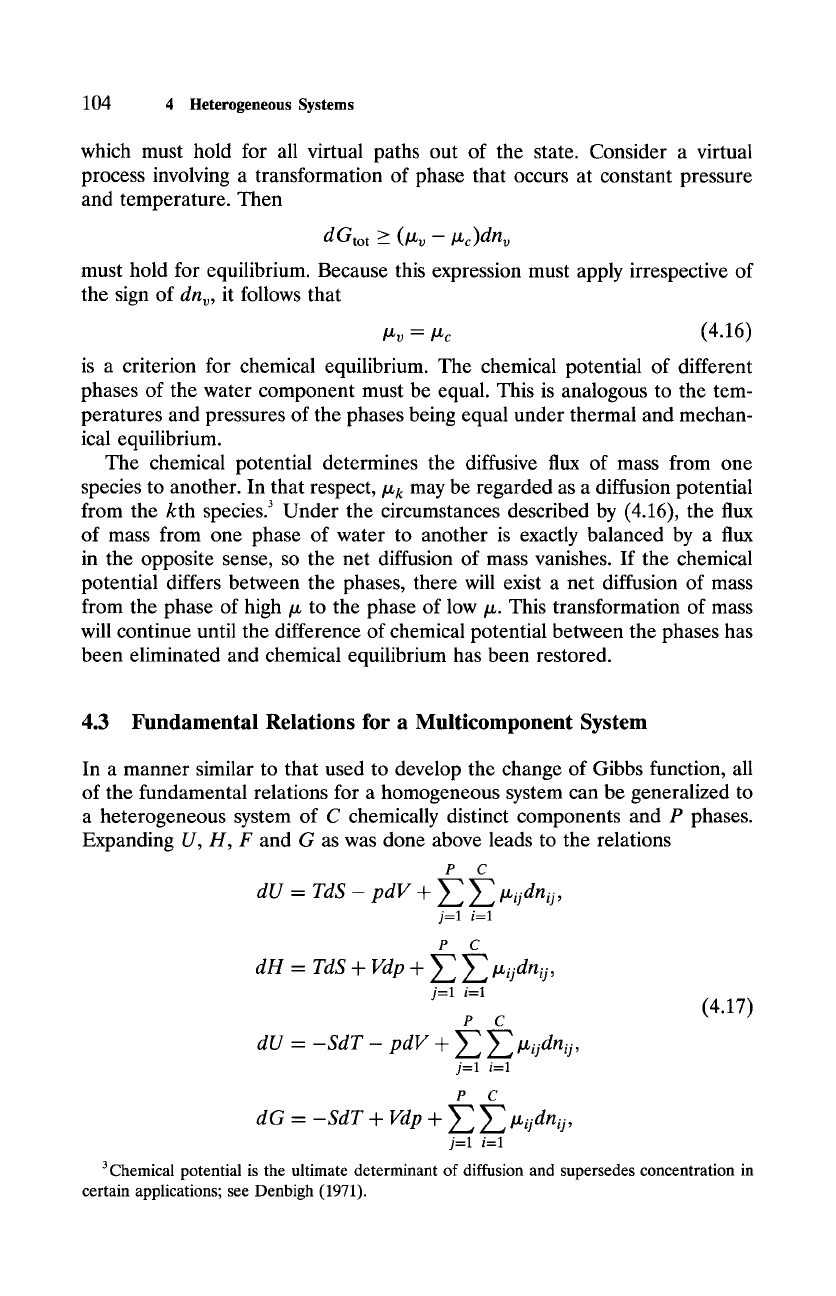
104
4
Heterogeneous Systems
which must hold for all virtual paths out of the state. Consider a virtual
process involving a transformation of phase that occurs at constant pressure
and temperature. Then
d
Gto t
> (I.l,v -- lzc)dn
v
must hold for equilibrium. Because this expression must apply irrespective of
the sign of
dn,,,
it follows that
/z v -/z c (4.16)
is a criterion for chemical equilibrium. The chemical potential of different
phases of the water component must be equal. This is analogous to the tem-
peratures and pressures of the phases being equal under thermal and mechan-
ical equilibrium.
The chemical potential determines the diffusive flux of mass from one
species to another. In that respect,/z k may be regarded as a diffusion potential
from the kth species) Under the circumstances described by (4.16), the flux
of mass from one phase of water to another is exactly balanced by a flux
in the opposite sense, so the net diffusion of mass vanishes. If the chemical
potential differs between the phases, there will exist a net diffusion of mass
from the phase of high/z to the phase of low/z. This transformation of mass
will continue until the difference of chemical potential between the phases has
been eliminated and chemical equilibrium has been restored.
4.3 Fundamental Relations for a Multicomponent System
In a manner similar to that used to develop the change of Gibbs function, all
of the fundamental relations for a homogeneous system can be generalized to
a heterogeneous system of C chemically distinct components and P phases.
Expanding U, H, F and G as was done above leads to the relations
P C
dU : TdS - pdV + ~ ~ldqjdnij ,
j=l i=l
P C
- ras + + Z Z i, ani,,
j=l
i=l
P C
au - -sa - par + Z Z,,i, ani,,
j=l i=1
(4.17)
P C
a c - -sat +vap + s ani,,
j=l i=1
3 Chemical potential is the ultimate determinant of diffusion and supersedes concentration in
certain applications; see Denbigh (1971).
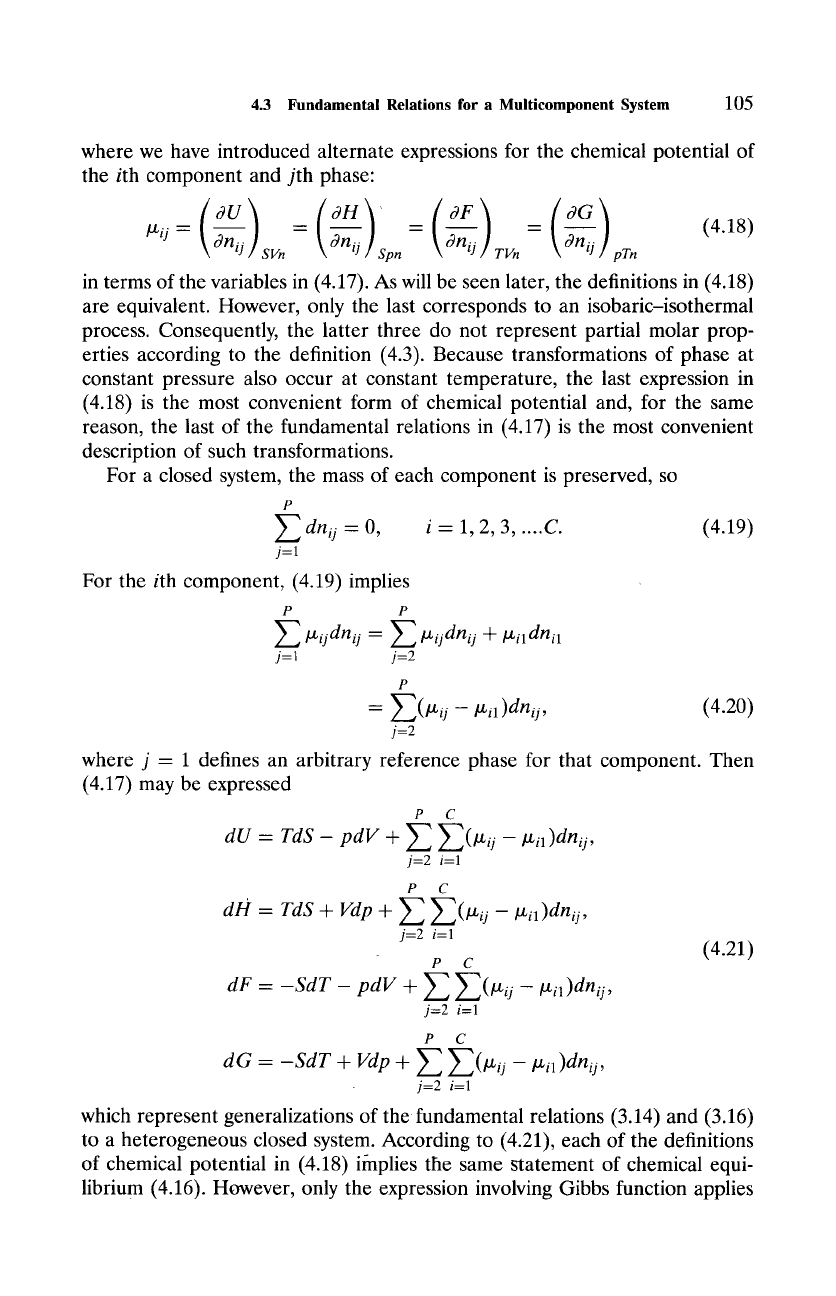
4.3 Fundamental Relations for a Multicomponent System
105
where we have introduced alternate expressions for the chemical potential of
the ith component and jth phase:
~ij ....
(4.18)
SVn Spn TVn pTn
in terms of the variables in (4.17). As will be seen later, the definitions in (4.18)
are equivalent. However, only the last corresponds to an isobaric-isothermal
process. Consequently, the latter three do not represent partial molar prop-
erties according to the definition (4.3). Because transformations of phase at
constant pressure also occur at constant temperature, the last expression in
(4.18) is the most convenient form of chemical potential and, for the same
reason, the last of the fundamental relations in (4.17) is the most convenient
description of such transformations.
For a closed system, the mass of each component is preserved, so
P
dnij - O, i - 1, 2, 3, .... C.
(4.19)
j=l
For the ith component, (4.19) implies
P P
Z tzijdnij - E tzijdnij +
~il drtil
j=l j=2
P
= Z(tzij - tZil)dnij,
(4.20)
j=2
where j = 1 defines an arbitrary reference phase for that component. Then
(4.17) may be expressed
P C
dU - TdS - pdV + y~ ~(tzij
- ].~il)drlij,
j=2 i=1
P c
dH - TdS + Vdp + ~ ~--~(tzij - ]J-'il )dFlij,
j=2 i=1
P C
dF - -SdT - pdV + Z
Z(ld'ij --
tzil)dnij '
j=2
i=l
(4.21)
P C
dG - -SdT + Vdp + Z Z(~iJ - p, ia)dnij,
j=2 i=1
which represent generalizations of the fundamental relations (3.14) and (3.16)
to a heterogeneous closed system. According to (4.21), each of the definitions
of chemical potential in (4.18) ffnplies the same statement of chemical equi-
librium (4.16). However, only the expression involving Gibbs function applies
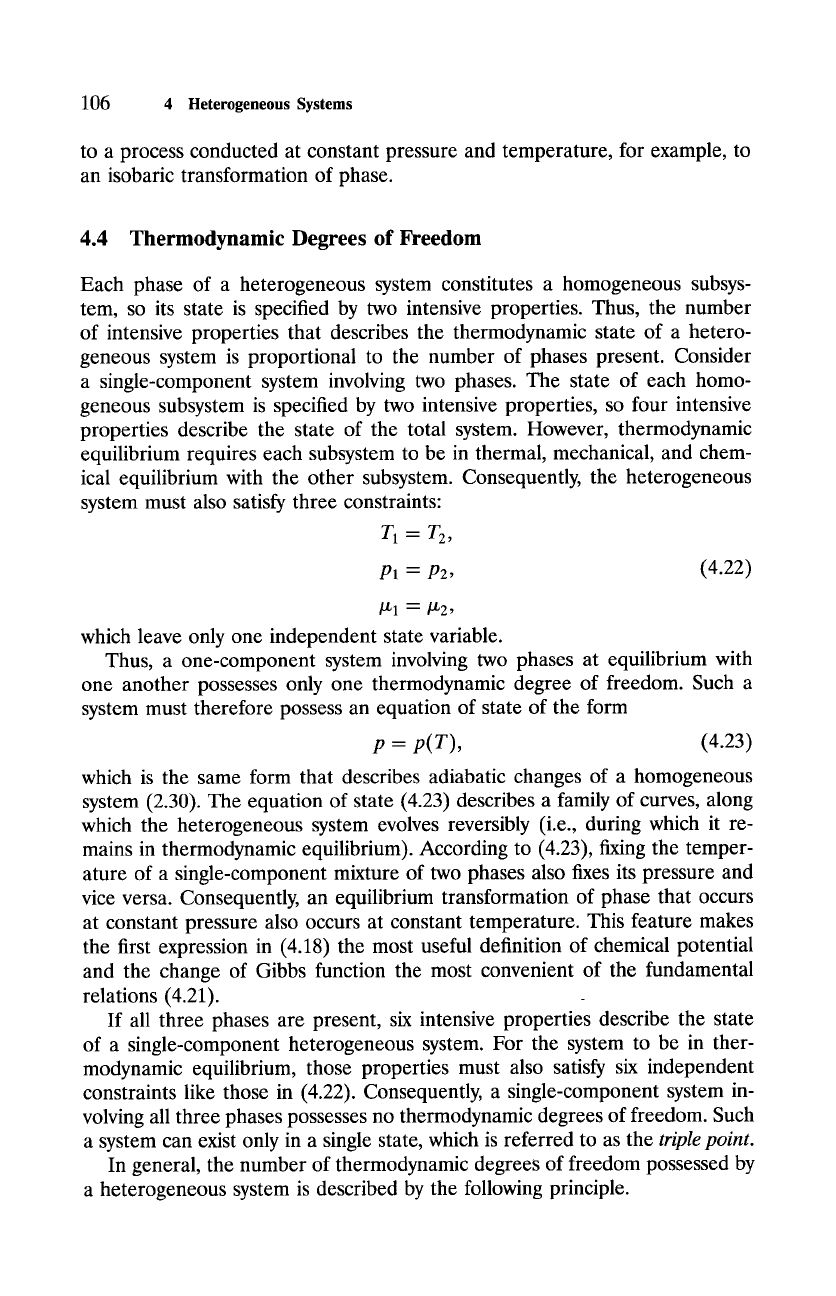
106
4 Heterogeneous Systems
to a process conducted at constant pressure and temperature, for example, to
an isobaric transformation of phase.
4.4 Thermodynamic Degrees of Freedom
Each phase of a heterogeneous system constitutes a homogeneous subsys-
tem, so its state is specified by two intensive properties. Thus, the number
of intensive properties that describes the thermodynamic state of a hetero-
geneous system is proportional to the number of phases present. Consider
a single-component system involving two phases. The state of each homo-
geneous subsystem is specified by two intensive properties, so four intensive
properties describe the state of the total system. However, thermodynamic
equilibrium requires each subsystem to be in thermal, mechanical, and chem-
ical equilibrium with the other subsystem. Consequently, the heterogeneous
system must also satisfy three constraints:
TI=T 2,
Pl = P2, (4.22)
~1 = /Z2,
which leave only one independent state variable.
Thus, a one-component system involving two phases at equilibrium with
one another possesses only one thermodynamic degree of freedom. Such a
system must therefore possess an equation of state of the form
p = p(T),
(4.23)
which is the same form that describes adiabatic changes of a homogeneous
system (2.30). The equation of state (4.23) describes a family of curves, along
which the heterogeneous system evolves reversibly (i.e., during which it re-
mains in thermodynamic equilibrium). According to (4.23), fixing the temper-
ature of a single-component mixture of two phases also fixes its pressure and
vice versa. Consequently, an equilibrium transformation of phase that occurs
at constant pressure also occurs at constant temperature. This feature makes
the first expression in (4.18) the most useful definition of chemical potential
and the change of Gibbs function the most convenient of the fundamental
relations (4.21).
If all three phases are present, six intensive properties describe the state
of a single-component heterogeneous system. For the system to be in ther-
modynamic equilibrium, those properties must also satisfy six independent
constraints like those in (4.22). Consequently, a single-component system in-
volving all three phases possesses no thermodynamic degrees of freedom. Such
a system can exist only in a single state, which is referred to as the
triple point.
In general, the number of thermodynamic degrees of freedom possessed by
a heterogeneous system is described by the following principle.
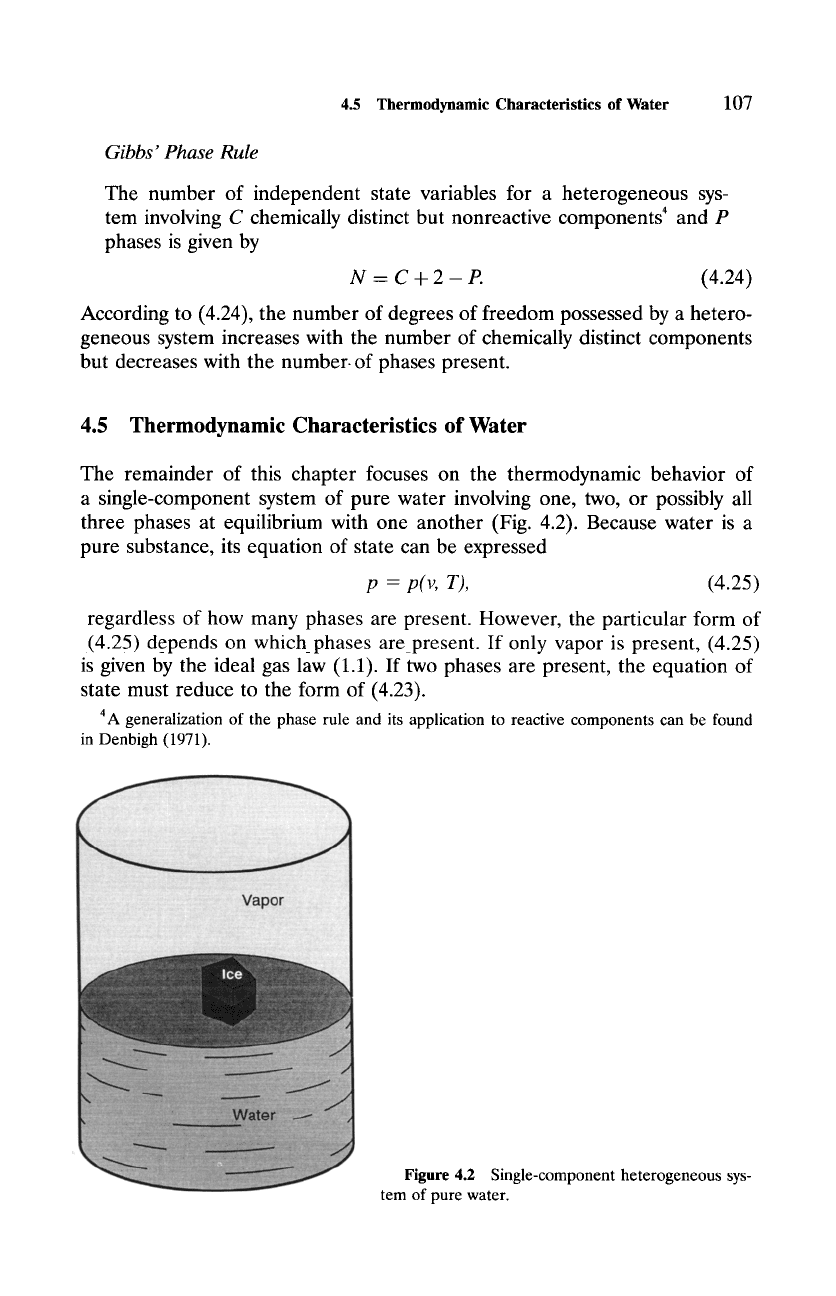
4.5
Thermodynamic Characteristics of Water
107
Gibbs' Phase Rule
The number of independent state variables for a heterogeneous sys-
tem involving C chemically distinct but nonreactive components 4 and P
phases is given by
N = C § 2 - P. (4.24)
According to (4.24), the number of degrees of freedom possessed by a hetero-
geneous system increases with the number of chemically distinct components
but decreases with the number, of phases present.
4.5 Thermodynamic Characteristics of Water
The remainder of this chapter focuses on the thermodynamic behavior of
a single-component system of pure water involving one, two, or possibly all
three phases at equilibrium with one another (Fig. 4.2). Because water is a
pure substance, its equation of state can be expressed
p = p(v, T),
(4.25)
regardless of how many phases are present. However, the particular form of
(4.25) depends on which_phases are_present. If only vapor is present, (4.25)
is given by the ideal gas law (1.1). If two phases are present, the equation of
state must reduce to the form of (4.23).
4A
generalization of the phase rule and its application to reactive components can be found
in Denbigh (1971).
I
Vapor
Figure 4.2 Single-component heterogeneous sys-
tem of pure water.
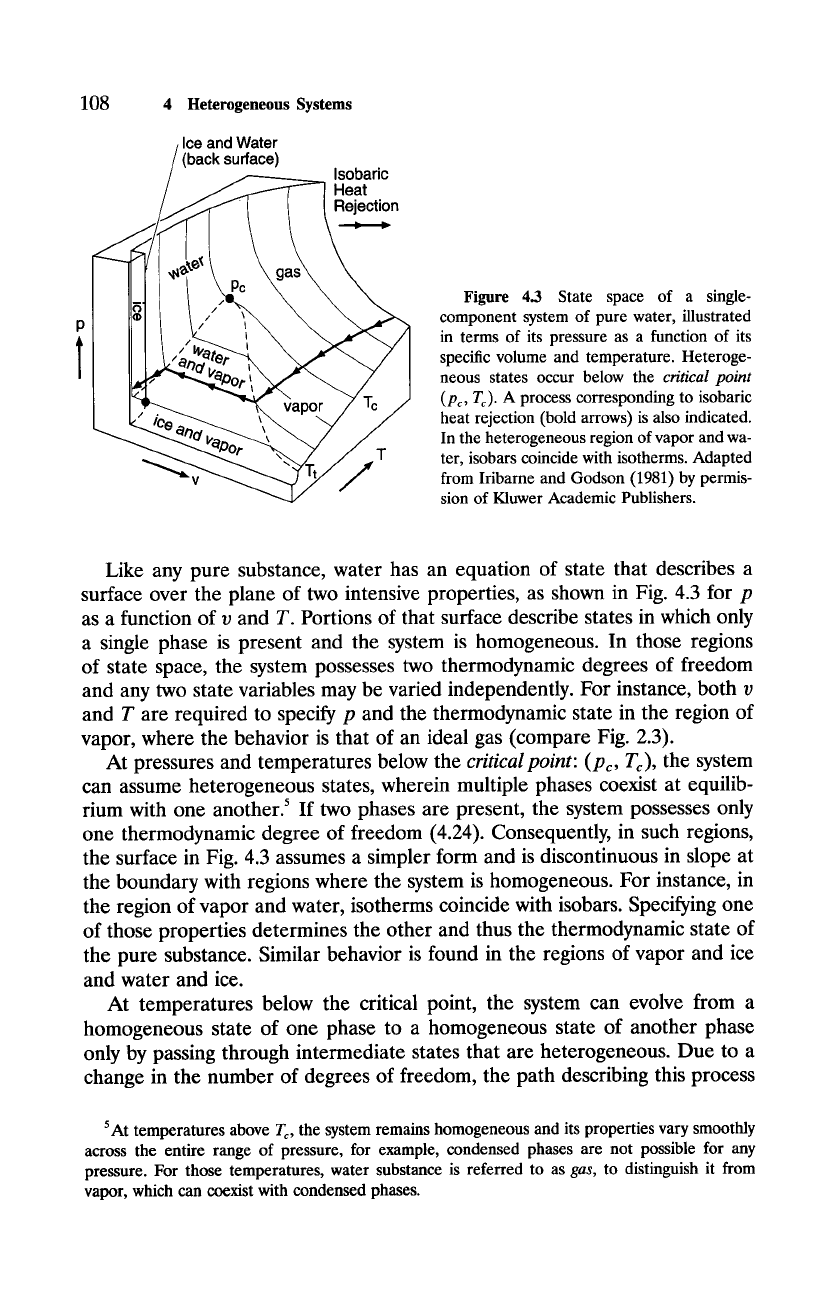
108 4
Heterogeneous Systems
Ice and Water
/ (back surface)
/ ~ Isobaric
/ ~~1
Heat
ection
/'~\ vapor /
Figure 4.3 State space of a single-
component system of pure water, illustrated
in terms of its pressure as a function of its
specific volume and temperature. Heteroge-
neous states occur below the
critical point
(Pc, Tc).
A process corresponding to isobaric
heat rejection (bold arrows) is also indicated.
In the heterogeneous region of vapor and wa-
ter, isobars coincide with isotherms. Adapted
from Iribarne and Godson (1981) by permis-
sion of Kluwer Academic Publishers.
Like any pure substance, water has an equation of state that describes a
surface over the plane of two intensive properties, as shown in Fig. 4.3 for p
as a function of v and T. Portions of that surface describe states in which only
a single phase is present and the system is homogeneous. In those regions
of state space, the system possesses two thermodynamic degrees of freedom
and any two state variables may be varied independently. For instance, both v
and T are required to specify p and the thermodynamic state in the region of
vapor, where the behavior is that of an ideal gas (compare Fig. 2.3).
At pressures and temperatures below the
critical point: (Pc, Tc),
the system
can assume heterogeneous states, wherein multiple phases coexist at equilib-
rium with one another? If two phases are present, the system possesses only
one thermodynamic degree of freedom (4.24). Consequently, in such regions,
the surface in Fig. 4.3 assumes a simpler form and is discontinuous in slope at
the boundary with regions where the system is homogeneous. For instance, in
the region of vapor and water, isotherms coincide with isobars. Specifying one
of those properties determines the other and thus the thermodynamic state of
the pure substance. Similar behavior is found in the regions of vapor and ice
and water and ice.
At temperatures below the critical point, the system can evolve from a
homogeneous state of one phase to a homogeneous state of another phase
only by passing through intermediate states that are heterogeneous. Due to a
change in the number of degrees of freedom, the path describing this process
5At temperatures above T o the system remains homogeneous and its properties vary smoothly
across the entire range of pressure, for example, condensed phases are not possible for any
pressure. For those temperatures, water substance is referred to as
gas,
to distinguish it from
vapor, which can coexist with condensed phases.
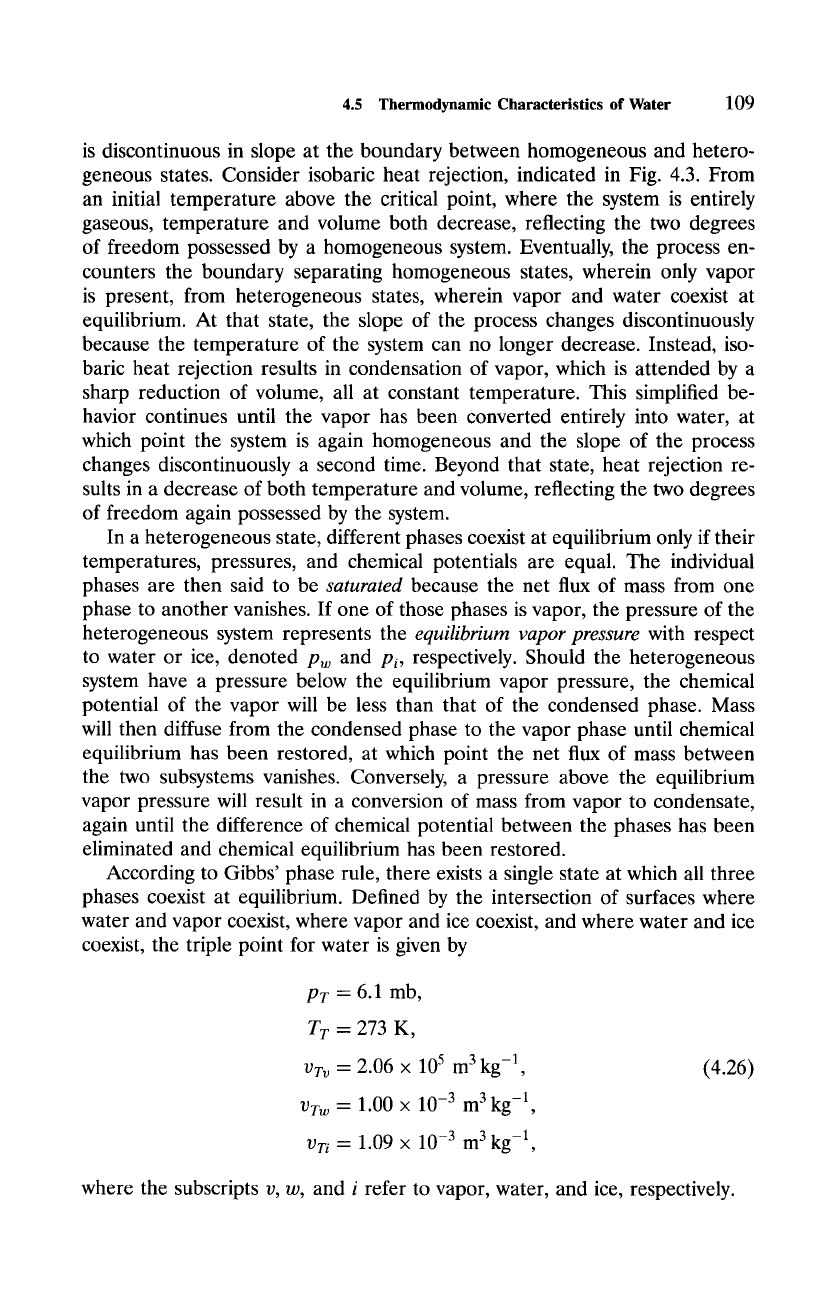
4.5
Thermodynamic Characteristics of Water
109
is discontinuous in slope at the boundary between homogeneous and hetero-
geneous states. Consider isobaric heat rejection, indicated in Fig. 4.3. From
an initial temperature above the critical point, where the system is entirely
gaseous, temperature and volume both decrease, reflecting the two degrees
of freedom possessed by a homogeneous system. Eventually, the process en-
counters the boundary separating homogeneous states, wherein only vapor
is present, from heterogeneous states, wherein vapor and water coexist at
equilibrium. At that state, the slope of the process changes discontinuously
because the temperature of the system can no longer decrease. Instead, iso-
baric heat rejection results in condensation of vapor, which is attended by a
sharp reduction of volume, all at constant temperature. This simplified be-
havior continues until the vapor has been converted entirely into water, at
which point the system is again homogeneous and the slope of the process
changes discontinuously a second time. Beyond that state, heat rejection re-
sults in a decrease of both temperature and volume, reflecting the two degrees
of freedom again possessed by the system.
In a heterogeneous state, different phases coexist at equilibrium only if their
temperatures, pressures, and chemical potentials are equal. The individual
phases are then said to be
saturated
because the net flux of mass from one
phase to another vanishes. If one of those phases is vapor, the pressure of the
heterogeneous system represents the
equilibrium vapor pressure
with respect
to water or ice, denoted
Pw
and
Pi,
respectively. Should the heterogeneous
system have a pressure below the equilibrium vapor pressure, the chemical
potential of the vapor will be less than that of the condensed phase. Mass
will then diffuse from the condensed phase to the vapor phase until chemical
equilibrium has been restored, at which point the net flux of mass between
the two subsystems vanishes. Conversely, a pressure above the equilibrium
vapor pressure will result in a conversion of mass from vapor to condensate,
again until the difference of chemical potential between the phases has been
eliminated and chemical equilibrium has been restored.
According to Gibbs' phase rule, there exists a single state at which all three
phases coexist at equilibrium. Defined by the intersection of surfaces where
water and vapor coexist, where vapor and ice coexist, and where water and ice
coexist, the triple point for water is given by
pv = 6.1 mb,
TT = 273 K,
vv~ = 2.06 • 105 m 3 kg -1,
V~w-
1.00 • 10 -3 m 3 kg -1,
vTi-
1.09 • 10 -3 m 3 kg -1,
(4.26)
where the subscripts v, w, and i refer to vapor, water, and ice, respectively.
